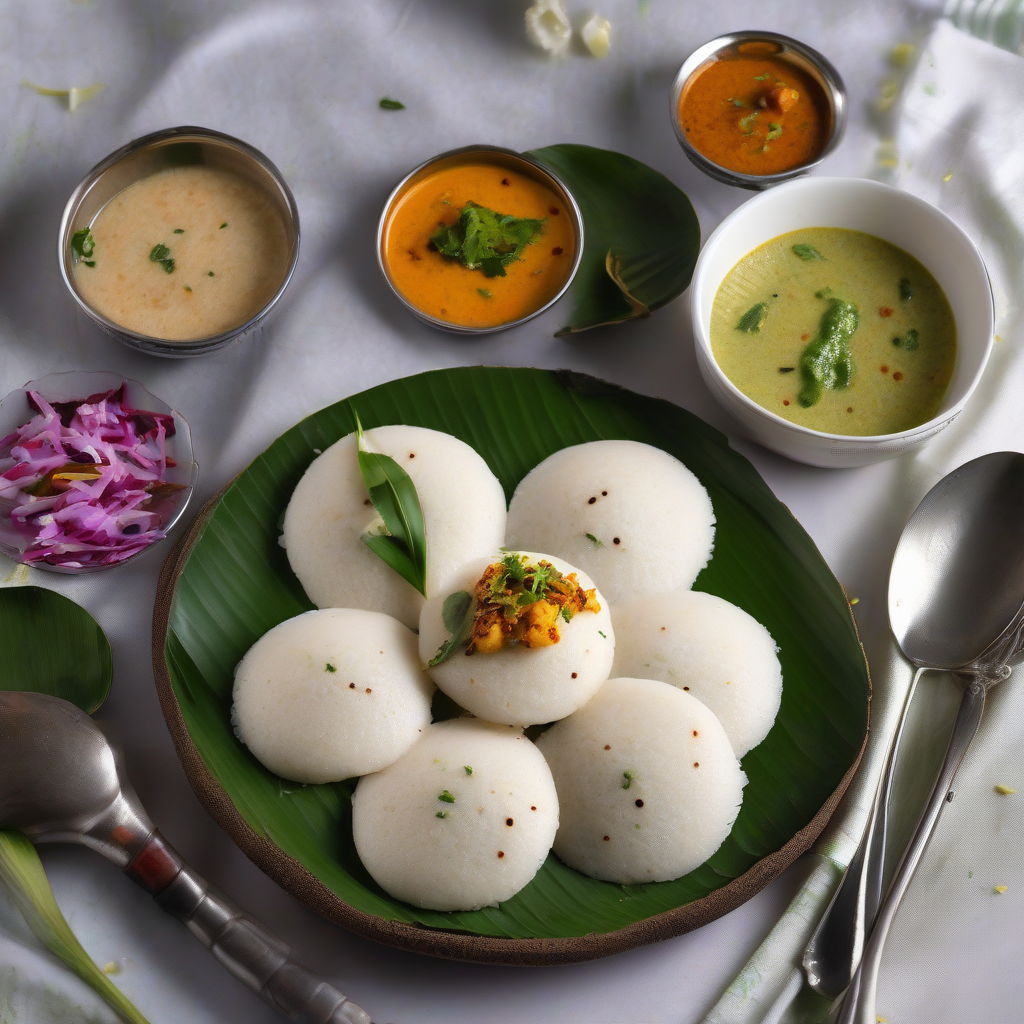Thatte Idli: Soft as Clouds, Big as Your Plate! – A South Indian Delight, Recreated by Chef Curry Do’pyaza!
Namaste Doston! Kem cho? Kai se ho aap sab?
Chef Curry Do’pyaza here, back with another delectable dish straight from the heart of South India! Today, we are diving into the world of Thatte Idli – those wonderfully soft, plate-sized idlis that are a true culinary experience. This is not just any idli; it’s a giant, fluffy cloud of goodness that will make your taste buds sing!
Thatte Idli is a popular breakfast dish in Karnataka, especially around Bangalore and Tumkur. You will find these beauties gracing breakfast tables during festive occasions like Ugadi, Sankranti, and even just a regular Sunday morning when the family wants something special. It is often eaten with a flavorful coconut chutney and sambar.
A Little History Lesson
“Thatte” means plate in Kannada, and these idlis are named so because they are steamed in plate-shaped molds. The origins are a little hazy, but many believe it originated in small eateries around Bangalore, where cooks wanted a larger, more satisfying idli for hungry customers. And boy, did they succeed!
Get Ready to Cook!
Preparation Time: 20 minutes (plus soaking time)
Cooking Time: 25-30 minutes
What You Need (Ingredients):
For the Idli:
- 2 cups Idli Rava (Cream of Rice)
- 1 cup Urad Dal (Split Black Gram, skinned)
- 1 teaspoon Methi Seeds (Fenugreek Seeds)
- Salt to taste
- Water, as needed
- 1/2 teaspoon Avalakki (Poha/ Flattened Rice)
For the Coconut Chutney:
- 1 cup grated fresh Nariyal (Coconut)
- 2-3 Hari Mirch (Green Chilies), adjust to your spice level
- 1/2 inch Adrak (Ginger)
- 2 tablespoons Dalia (Roasted Gram)
- Salt to taste
- Water, as needed
- For Tempering: 1 tablespoon oil, 1/2 teaspoon Rai (Mustard Seeds), 1-2 Sukhi Lal Mirch (Dry Red Chilies), a sprig of Kadi Patta (Curry Leaves)
Let’s Get Cooking! (Instructions):
- Soaking Time: Wash the Urad Dal and Methi Seeds together thoroughly. Soak them in plenty of water for at least 4-5 hours, or preferably overnight. Separately, soak the Idli Rava and Avalakki for just 30 minutes. This softens the grains, making them light and airy.
- Grinding the Batter: Drain the Urad Dal and Methi Seeds. Grind them in a wet grinder or a high-powered blender with enough water to form a smooth, fluffy batter. The batter should be light and airy.
- Mixing it All Together: In a large bowl, combine the ground Urad Dal batter, soaked Idli Rava, and Avalakki. Add salt to taste. Mix everything well with your hands. The batter should have a thick, pouring consistency.
- Fermentation is Key: Cover the bowl and let the batter ferment in a warm place for 8-10 hours, or overnight. This is crucial for the idlis to become soft and fluffy. The batter should rise and become bubbly.
- Greasing the Plates: Grease the thatte idli plates (or any small, flat plates) with a little oil. This prevents the idlis from sticking.
- Steaming the Idlis: Pour the batter into the greased plates, filling them about three-quarters full.
- Steaming Options:
- Traditional Steamer: Place the plates in a steamer and steam for 15-20 minutes, or until a toothpick inserted into the center comes out clean.
- Pressure Cooker: You can also steam them in a pressure cooker without the whistle. Add water to the cooker, place a stand inside, and steam the idlis for the same amount of time.
- Induction Stove: Use an idli steamer compatible with induction cooktops.
- Microwave: Not recommended for traditional steaming, as it can make the idlis rubbery.
- Making the Coconut Chutney: While the idlis are steaming, let’s make the chutney. Grind all the chutney ingredients (coconut, green chilies, ginger, roasted gram, and salt) with a little water to a smooth paste.
- Tempering the Chutney: Heat oil in a small pan. Add mustard seeds and let them splutter. Add dry red chilies and curry leaves. Pour this tempering over the chutney.
- Serving Time: Once the idlis are cooked, let them cool slightly before removing them from the plates. Serve hot with the flavorful coconut chutney.
Tips for the Perfect Thatte Idli:
- Fermentation is Crucial: Don’t rush the fermentation process. A well-fermented batter is the secret to soft idlis.
- Batter Consistency: The batter should not be too thick or too thin. A medium, pouring consistency is ideal.
- Steaming Time: Avoid over-steaming, as it can make the idlis dry.
- Use good quality Idli Rava: The quality of the rava affects the final texture of the idlis.
- A pinch of Baking Soda: If you live in a cold climate, you can add a pinch of baking soda to the batter before steaming to help with the fluffiness.
Cooking with Different Methods:
- Gas Stove: The traditional method, perfect for steaming.
- Induction Stove: Use an induction-compatible steamer.
- Pressure Cooker: A quick and easy alternative to a traditional steamer.
- Air Fryer: Not suitable for this recipe.
- Microwave: Not recommended.
- Slow Cooker/Crockpot: Not suitable for this recipe.
Nutritional Information (Approximate, per Idli):
- Calories: 150-200
- Protein: 5-7 grams
- Carbohydrates: 30-35 grams
- Fat: 2-3 grams
Serving Suggestions:
- Serve hot with coconut chutney and sambar.
- A dollop of ghee on top adds richness and flavor.
- Enjoy with a cup of hot filter coffee for a truly South Indian experience.
A Final Word from Chef Curry Do’pyaza
There you have it, folks! My take on the classic Thatte Idli. I encourage you to try this recipe at home. It is a fantastic way to bring a piece of South India to your kitchen. This is a beautiful dish that will impress your friends and family.
Happy Cooking, and remember, Khana Khao, Mast Raho! (Eat well, stay happy!) Share the joy of cooking and good food with your loved ones.
